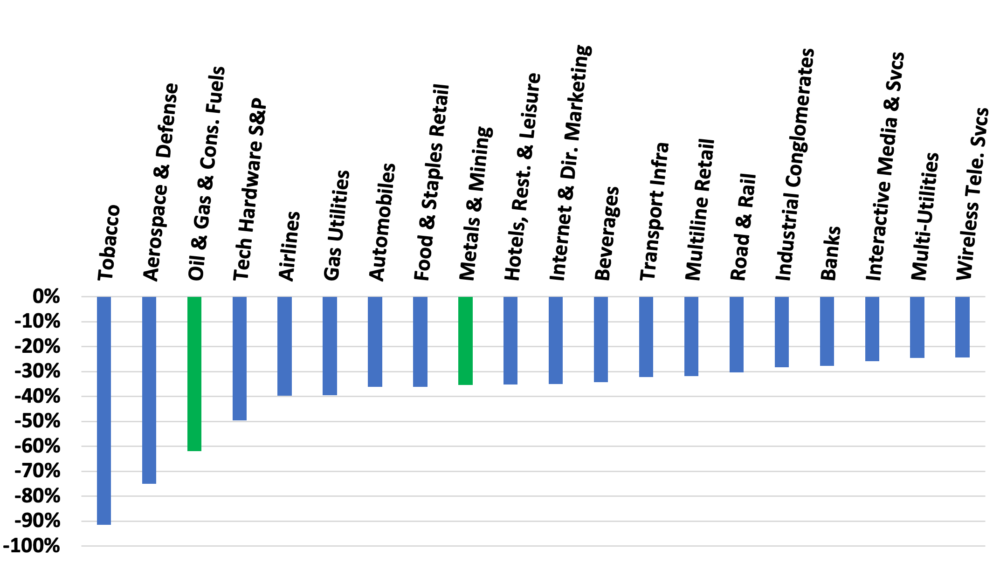Extractive industries represent a meaningful challenge for responsible investors. The energy transition currently relies on industries that typically have significant negative externalities, yet solutions exist for this paradox.
The Challenge
Electrification requires large amounts of copper, for conducting electricity, and battery materials such as cobalt and lithium, for storing it. Mining these minerals entails substantial ESG (environment, social, governance) risks. Extractive industries are often, by nature, tough on the environment. Further, many mines operate in emerging economies with substantial risks due to lower living standards, reduced social protections, and lax governance and environmental regulations.
Fossil fuels also play a critical role in the energy transition. They still provide the bulk of global energy and, unfortunately from an environmental standpoint, will be with us for decades. Simplistically, we would like to see reduced production of all hydrocarbons, but natural gas emits less carbon dioxide and pollution than other fossil fuels (50% less CO2 than coal when producing electricity), so it can be used to displace coal and backstop intermittent renewables like wind and solar.
Solutions
One approach to investing in extractive industries is simply to exclude those companies from investment portfolios. Many ESG-minded investors have adopted this stance and therefore may be underinvested in materials needed for the energy transition (Exhibit 1).
Exhibit 1: ESG Funds Underweight Key Energy Transition Materials vs. MSCI ACWI

As of June 2022. Shows weight of ESG funds relative to MSCI AC World Index. Source: Goldman Sachs Investment Research.
An alternative approach seeks out companies that are either best-in-class or show credible signs of improvement toward more sustainable operations, acknowledging that some extractive industries may have a place in transitioning to a more sustainable future. Clearbridge created a framework for responsibly investing in these more sustainably-minded companies. Participating in these sectors also enables engagement, a key tenet of active ownership.
Environmental Factors
Environmental considerations are front and center for our ESG framework for extractive industries. Our environmental assessment scrutinizes a company’s:
- Environmental efficiency of operations
- Land usage and impact
- Water usage and water pollution
- Scope 1 and 2 emission reduction targets
- Greenhouse gas emission disclosure in line with the Task Force on Climate-related Financial Disclosures (TCFD) and the Sustainability Accounting Standards Board (SASB)
- Contribution to clean technology, such as electrification
- Position on the cost curve: Lower-cost producers can be more profitable and therefore better positioned to weather the volatility of the commodity cycle, and thereby better positioned to support the energy transition
Environment Factor: Water Management
Water management is a core consideration for miners. Water is a necessary input for mines, smelters and processing facilities, but it should be used in an efficient way to minimize environmental and community impacts. A copper producer we have engaged with, for example, provides clear disclosure on the source of its water requirements (i.e. groundwater, surface water), and looks to minimize its use of freshwater in its operations via effluent water use from local municipalities. It also makes local investments in regions by constructing dams, water lines and wastewater treatment facilities that can benefit internal operations and the local community, another best practice.
One best practice is to reuse as much water as possible. Similar to the above-mentioned copper producer, which recycles or reuses 82% of its water requirements, we visited and engaged with a U.S. mining company that has a facility producing rare earths used in electric vehicle motors. The facility recycles all water from its process such that recycled water meets 95% of the facility’s water needs, while the rest comes from groundwater. Engaging the company, we encouraged it to disclose the groundwater extraction quantities that make up the other 5% and compare these to peers.
Social and Governance Factors
While environmental concerns predominate in extractive industries, social and governance considerations remain critical and, taken together, could roughly equal the total weight of environmental factors. In an ESG framework for extractive industries, among social and governance considerations one could weigh:
- Disclosures: Clear and detailed disclosures underpin any active management approach to engaging for improvements in any of the environmental factors
- Stakeholder engagement: Extractive industries impact their host communities in particularly challenging ways, it is critical that companies work constructively with all their stakeholders
- Health and safety: Does a company have strong targets and execution?
- Board effectiveness: Does the board incentivize management and hold it accountable for ESG execution?
Publication of sustainability and water stewardship reports is also considered a best practice. In addition to environmental information, such reports should include clear information on community engagement and efforts to enable healthy, thriving communities where these companies operate. In terms of supply chain transparency, for companies with extensive international operations, it is important to look for robust analysis of local employment rates to better understand underlying social issues in distant geographies.
If investors wish to proactively help the energy transition along, they will need to allocate capital to some extractive industries. A responsible, active approach to doing this can put environmental factors first and seek out companies that are either best-in-class or show credible signs of improvement toward more sustainable operations.
RIA Disclaimer
The views and opinions expressed in this article are solely those of the authors and do not necessarily reflect the view or position of the Responsible Investment Association (RIA). The RIA does not endorse, recommend, or guarantee any of the claims made by the authors. This article is intended as general information and not investment advice. We recommend consulting with a qualified advisor or investment professional prior to making any investment or investment-related decision.


